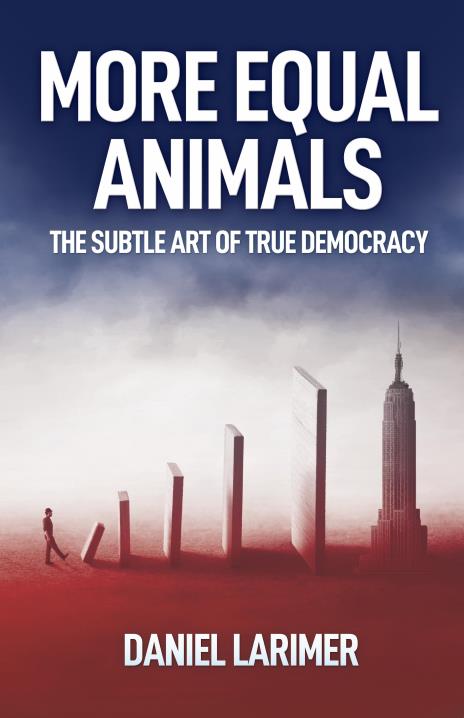The Sovereignty of Blockchains
Public blockchains such as Bitcoin, Ethereum, Hive, and EOS are supranational organizations of people cooperating to reach consensus. This means they exist in a realm beyond the jurisdiction of any country. It is the supranational nature of blockchain that creates the potential to provide freedoms that exist outside the absolute control of any individual country or regulator. A blockchain is sovereign over the consensus of the people who use it. There are no higher courts of appeal than the consensus process and it is this sovereignty that serves as the core value proposition of decentralized public blockchains. In this post, I hope to make the case that it is in everyone’s interest to support the independence and sovereignty of community consensus even if you disagree with the outcome.
The consensus of blockchain communities depends on a user base’s universal agreement on the deterministic code interpreting the agreed ordering of signed messages. This agreement on code and order is the ultimate authority and the source of the sovereignty of all blockchains. This means that the definition of “right” and “wrong” is determined by two methods: code is law, and use is consent.
When someone buys a token they are joining a sovereign community and consenting to the chosen consensus algorithm. This is like buying land in a new country and the land is subject to that country's sovereign laws. When you sell a token it is like selling land and freeing your property from that country’s laws. If the Supreme Court of The United States makes a ruling that authorizes the transfer of your land (within the USA) to someone else or to the government, then no other country has the right or power to reverse that decision. Only a change in the laws of the United States whether by elected legislators or a popular revolution can reverse the decision.
Revolution vs. Legislation
When it comes to blockchains, a revolution is expressed as a User Activated Hard Fork and occurs when the majority of influential users switch to a new code base and thereby change the consensus rules without any consideration for the sovereignty of the status quo “powers that be”, within a blockchain community. Examples of this include Bitcoin/BitcoinCash/SV, Ethereum/Ethereum Classic, and Steem/Hive. All of these “forks” required the users of a blockchain to upgrade their code and the dissenters had the option of maintaining the old blockchain based upon the prior code. In effect, User Activated Hard Forks are like secession movements where a subset of a country's population and territory create a new sovereign country.
A “legislation” driven change in the sovereign blockchain law occurs when the rules of the existing “code” are used to upgrade the “code”. Some blockchains, like EOS, Hive, and BitShares, have powerful on-chain governance mechanisms which enable them to express community consensus on subjective matters through elected representatives. These subjective matters include the concept that the “intent of code is law” and it empowers communities to fix bugs without a “revolution”. EOS, in particular, is one of the most powerful and dynamic “legislative” consensus algorithms out there because the vast majority of its “law” or “code” is implemented as a smart contract that can be updated by elected representatives according to the existing objective “code is law” framework. This means that the EOS community is incredibly flexible and able to achieve a far more powerful consensus on subjective matters without risking a blockchain revolution.
With great power comes great responsibility. If the elected representatives of a DPOS chain (Delegated Proof of Stake) such as EOS, Hive, and others abuse their power then the community can and will start a blockchain revolution/secession movement. This is what happened when Tron bought Steemit and started acting in ways disapproved of by the community. When the community took “legislative action” to lock Steemit’s account, Steemit worked with exchanges to exercise the power of their depositor’s tokens to “reverse” the prior “legislative action” and ram through Steemit’s own “legislative” changes to the protocol. Ultimately, the community revolt took the form of secession where a large percentage of the user base left to form HIVE. Today, Steem is worth $350m and Hive is worth $250m. Both sides took “legislative” action to seize the tokens that belonged to the other side to protect their internal governance. This is the reasonable and necessary act of revoking the voting rights of those being evicted from the community.
In the case of Steem/Hive or Ethereum/Ethereum Classic, there is no universal definition of “right” or “wrong” nor “appeal to authority”. Instead, the definition of “right” and “wrong” is encoded into the code and judged by each user when he or she chooses which code to adopt. The community of users of the respective chains is sovereign and their power is expressed by each individual’s choice to use one, both, or neither chain.
In my book, “More Equal Animals - The Subtle Art of True Democracy”, I explore how all law and authority is ultimately derived from nature. Within nature, “might makes right”. Communities of people cooperating are stronger together than the same community acting without coordination. All of our “rights” and “property” only exist to the extent that we as individuals can defend them by working together against other groups of individuals looking to “violate our rights”. In order to work together to defend our rights, we need a means of reaching consensus. Powerful communities are composed of members who generally support the consensus outcome even if they have a different opinion. They work “within” the system to change things and in exchange, their community has stronger cohesion and power. This works until the consensus process itself is corrupted to serve the needs of the few.
The key to defending against tyranny, and the reason blockchains exist, is to defend the people’s ability to achieve a new consensus that is truly representative of a population of voluntary users. Tyrants work to prevent a population from reaching a new consensus that would remove their power by utilizing the tactics of division, censorship, collusion, corruption, and/or outright fraud. It is through these processes that “democratic” countries are captured and turn into covert (or overt) tyrannies that operate without the approval of the majority of the population. Despite universal agreement that the existing consensus is “flawed”, the population is unable to effectively organize around a new consensus and therefore are subject to the tyranny of the status quo.
One of the principles outlined in “More Equal Animals” is that all true democracies must support the right of secession. An individual must maintain the ability to secede from the group and the group must maintain the ability to secede from the individual. Without the right of secession, there can be no certainty that consent is voluntary, and without the option for voluntary consent, provided by the right of secession, there can be no “legitimacy” to a consensus formed under such conditions. All that remains absent voluntary consent, is raw power under the law of the jungle.
From this perspective, it is not “theft” for a community to utilize its sovereign legislative and revolutionary consensus processes to reallocate blockchain assets. Anyone who disagrees with the “legislative” laws is free to leave by selling their tokens or creating their own secession/revolutionary movement (like Hive). A blockchain governed by an unpredictable and unreasonable legislative process will see a migration away to other chains. A blockchain that effectively wields reasonable and predictable subjective power for the good of the community may attract people. This is the power behind the “intent of code is law”. Not everyone likes the cold consensus of immutable “code is law” and they welcome the “safety” of a subjective consensus process.
The “citizens” being “banished” or “excommunicated” from a community may protest and suffer a loss of influence and material well-being. In this case, they may seek revenge under the law of the jungle to reverse the banishment or recover assets. In the blockchain world, these actions often take the form of lawsuits filed against other community members. The goal of the lawsuit is to apply the full force of government coercion against individual “citizens” because of their “sovereign” actions in a blockchain community. This is like a banished king fleeing to a neighboring country and rallying their support for a special ops team to infiltrate and overthrow their prior kingdom.
Everyone in the blockchain space needs to align behind the sovereignty of blockchain consensus, whether achieved via “on-chain legislation” or via “off-chain hard forking revolution”. We can allow the free market and voluntary association to determine which sovereign communities prosper through a growing economy and currency and which “banana blockchains” decline through a loss of their citizens who immigrate to better-governed communities. If we instead opt to invite existing governments in to resolve disputes among members of our blockchain communities then we undermine all efforts to free ourselves via voluntary participation in new community-driven consensus processes.
Respect for the sovereignty of blockchain consensus is the most fundamental and universal principle that every blockchain user must support. It would be a tragedy if we allowed the corrupt governments that motivated Satoshi to create Bitcoin to define the community consensus rules by threatening those who choose to exercise their freedom of speech and freedom association to effect change in the world. We must not legitimize the use of government courts to resolve disputes regarding an individual or group’s voluntary on-chain actions. We must not undermine the intended independence of blockchain communities by encouraging existing governments to enforce their interpretation and imputation of the meaning of community agreements.
block.one & EOS

Over the past several months I have heard many people suggest that block.one has not been living up to their expectations and, therefore, that their tokens or vesting tokens should be revoked or repurposed. This situation is not helped by the fact that the intent of the social contract and expectations of block.one by the community are ambiguous and varied.
I have been working with the EOS community to utilize the revolutionary governance process from my book to elect hundreds of vetted and trusted representatives to allocate funds to build the EOS ecosystem. We call this governance process Eden OS (defining the E in EOS). Almost everyone I have talked to in the community has expressed support for Eden, and my developers have been working to build the technological infrastructure to make it possible. This infrastructure should be complete and the first elections held this summer.
I have also been talking with Brendan Blumer about block.one funding the Eden community utilizing their EOS and have received strong indications that he desires to support Eden with ample funding while it matures. I believe that the most unifying and positive path forward is for block.one to voluntarily support Eden using their EOS. This will decentralize ownership of EOS while preventing the need for inflation to fund community development for at least 7 years. Most importantly this will build community unity and create positive momentum for EOS. For the sake of the community, I hope that block.one will publicly commit to a plan to fund Eden in order to meet the very real needs of the community for transparency and certainty regarding what they are receiving in exchange for the hundreds of millions of dollars of vesting EOS allocated to block.one when the community launched the chain.
That said, due to the principles laid out in this post, I believe the block producers are vested with the power to subjectively interpret the intent of the vesting restrictions placed on block.one’s tokens. If they chose to secede from block.one and repurpose the vesting tokens then I would support the legitimacy of the action while simultaneously disagreeing with such a move given Brendan’s expressed intent to voluntarily support the Eden community. I believe that the community would be stronger by working with block.one to fund Eden rather than creating unnecessary fear, uncertainty, and doubt about EOS within the crypto community. For this reason, I hope that any block producers reading this post carefully consider my opinion before taking potentially unnecessary, far-reaching, and potentially unproductive actions.
A Vision for Eden on EOS

This vision presents a strategy to fund several hundred people to build and promote EOS and projects on the EOS network. It leverages the unique advantages brought by block.one and those brought by a robust decentralized community building on EOS.
EOS has a unique opportunity to be the first blockchain community to leverage EdenOS’s implementation of true democracy to securely direct funds to the community-driven projects that need them the most. It does this by appointing 100’s of people and giving them authority over a limited budget. If everything goes according to design then EOS could become one of the most robustly funded communities in the crypto space.
The Eden election process is designed to ensure integrity with several techniques including provably unique real human participation and the vetting of all new members to the community by existing members. This means that the Eden election process is much more immune to common sybil attacks as well as immune from the collusion of insiders to extract community wealth for private gain without consequence.
The question I have been asking myself is what is the safest and most robust way to test this experimental process and ensure that corruption doesn’t unexpectedly overwhelm the system? In the long run, if the system works as I believe it should, then the EOS community could fund continuous ongoing community growth and development by allocating 10 to 20 million EOS per year (about $50m to $100m at today’s prices) to community governance.
The safest, least controversial, way to fund the Eden community is for Block.one to utilize their EOS stake to fund the elected Eden community representatives. This would represent a budget of about 800,000 EOS per month and elections would be hosted every 6 months. I could work with Block.one to ensure that the community governance is operating as designed and that no one is taking advantage of the system in an unexpected and unrecoverable manner. As long as Eden is operating within design parameters it would continue to receive funding. In the unexpected event that Eden is systemically corrupted then I would work to design and implement new countermeasures to protect community funding. Block.one would then be able to redirect the remaining funds to an improved system if necessary.
To truly test the power of Eden it is necessary to have enough money on the line to motivate people to push the limits. With millions of EOS per election, there is over $50 million dollars per year up for grabs to be used for development and also at risk to those attempting to exploit the community. Of the 4.8 million EOS per election, 1.6m EOS would be granted to individual elected to the position of “Satoshi”, 160k EOS would be given to each of the top 10 representatives, and 16,000 EOS would be given to the top 100 representatives out of a total of over 1000 Eden community members.
In total 100 people could receive enough funds to work full time or fund someone else to work full time. 10 people could receive enough funds to hire a small high-quality development team, while the elected “Satoshi” would receive a budget capable of funding a dozen different teams. In total, the community would be able to utilize the funding to empower 200-300 people to advance the adoption of EOS.
I believe that this outcome would ignite a renaissance in the EOS community and potentially have a far-reaching impact on how everyone cooperates to secure life, liberty, property, and justice for all.
比特币、以太坊、Hive 和 EOS 等公共区块链是人们合作达成共识的超国家组织。这意味着它们存在于任何国家管辖范围之外的领域。正是区块链的超国家性质创造了提供不受任何单个国家或监管机构绝对控制的自由的潜力。区块链对使用它的人的共识具有主权。没有比共识过程更高的上诉法院,正是这种主权作为去中心化公共区块链的核心价值主张。在这篇文章中,我希望说明即使你不同意结果,支持社区共识的独立性和主权也符合每个人的利益。
区块链社区的共识取决于用户群对确定性代码的普遍协议,该代码解释了已签署消息的商定顺序。这个关于代码和秩序的协议是所有区块链的最终权威和主权的来源。这意味着“正确”和“错误”的定义由两种方法确定:代码即法律,使用即同意。
当有人购买代币时,他们加入了一个主权社区并同意所选的共识算法。这就像在一个新国家购买土地,土地受该国主权法律的约束。当您出售代币时,就像出售土地并将您的财产从该国的法律中解放出来一样。如果美国最高法院作出一项裁决,授权将您的土地(在美国境内)转让给其他人或政府,那么任何其他国家都没有权利或权力推翻该决定。只有通过民选立法者或民众革命改变美国法律才能扭转这一决定。
革命与立法
当谈到区块链时,一场革命表现为用户激活的硬分叉,当大多数有影响力的用户切换到新的代码库并因此改变共识规则而不考虑现状“权力的主权”时,就会发生革命。 ”,在区块链社区内。这方面的例子包括比特币/BitcoinCash/SV、以太坊/以太坊经典和 Steem/Hive。所有这些“分叉”都要求区块链的用户升级他们的代码,反对者可以选择根据之前的代码维护旧的区块链。实际上,用户激活的硬分叉就像分裂运动,一个国家的人口和领土的一部分创建了一个新的主权国家。
当现有“代码”的规则被用于升级“代码”时,主权区块链法律发生“立法”驱动的变化。一些区块链,如 EOS、Hive 和 BitShares,具有强大的链上治理机制,使它们能够通过民选代表表达社区对主观问题的共识。这些主观问题包括“代码的意图就是法律”的概念,它使社区能够在没有“革命”的情况下修复错误。EOS, in particular, is one of the most powerful and dynamic “legislative” consensus algorithms out there because the vast majority of its “law” or “code” is implemented as a smart contract that can be updated by elected representatives according to the existing客观的“代码即法律”框架。
拥有权利的同时也被赋予了重大的责任。If the elected representatives of a DPOS chain (Delegated Proof of Stake) such as EOS, Hive, and others abuse their power then the community can and will start a blockchain revolution/secession movement. 这就是当 Tron 收购 Steemit 并开始以社区不赞成的方式行事时发生的事情。当社区采取“立法行动”锁定 Steemit 的账户时,Steemit 与交易所合作,行使存款人代币的权力,以“逆转”先前的“立法行动”,并通过 Steemit 自己对协议的“立法”变更。最终,社区反抗采取了分离的形式,其中很大一部分用户群离开形成 HIVE。今天,Steem 价值 3.5 亿美元,Hive 价值 2.5 亿美元。双方采取“立法”行动,没收属于对方的代币,以保护其内部治理。这是撤销被驱逐者的投票权的合理和必要的行为。
在 Steem/Hive 或 Ethereum/Ethereum Classic 的情况下,没有“正确”或“错误”或“诉诸权威”的通用定义。相反,“正确”和“错误”的定义被编码到代码中,并由每个用户在选择采用哪种代码时进行判断。各个链的用户社区是主权的,他们的权力通过每个人选择使用一个、两个或一个链来表达。
在我的书中,“更平等的动物——真正民主的微妙艺术”,我探索所有的法律和权威是如何最终源于自然的。在大自然中,“强权即是”。人们合作的社区比没有协调的同一个社区更强大。我们所有的“权利”和“财产”仅存在于我们作为个人可以通过与其他寻求“侵犯我们的权利”的个人团体合作来捍卫它们的范围内。为了共同捍卫我们的权利,我们需要一种达成共识的方法。强大的社区由通常支持共识结果的成员组成,即使他们有不同的意见。他们在系统“内部”工作以改变事物,作为交换,他们的社区具有更强的凝聚力和力量。这一直有效,直到共识过程本身被破坏以服务少数人的需求。
防御暴政的关键,以及区块链存在的原因,是捍卫人们达成真正代表自愿用户群体的新共识的能力。暴君通过使用分裂、审查、勾结、腐败和/或彻头彻尾的欺诈等策略来阻止民众达成新的共识,从而取消他们的权力。正是通过这些过程,“民主”国家被俘虏并变成了秘密(或公开)的暴政,这些暴政在未经大多数人口批准的情况下运作。尽管普遍认为现有共识存在“缺陷”,但民众无法围绕新共识有效地组织起来,因此受制于现状的暴政。
“更平等的动物”中概述的原则之一是,所有真正的民主国家都必须支持分离权。个人必须保持脱离群体的能力,群体必须保持脱离个人的能力。没有分离权,就无法确定同意是自愿的,如果没有分离权提供的自愿同意选项,在这种情况下形成的共识就没有“合法性”。在没有自愿同意的情况下,剩下的只是丛林法则下的原始权力。
从这个角度来看,社区利用其主权立法和革命性共识流程重新分配区块链资产并不是“盗窃”。任何不同意“立法”法律的人都可以通过出售他们的代币或创建自己的分离/革命运动(如 Hive)来自由离开。由不可预测和不合理的立法程序管理的区块链将迁移到其他链。为了社区的利益而有效地运用合理和可预测的主观力量的区块链可能会吸引人们。这就是“代码的意图就是法律”背后的力量。不是每个人都喜欢一成不变的“代码就是法律”的冷酷共识,他们欢迎主观共识过程的“安全性”。
被社区“驱逐”或“逐出教会”的“公民”可能会抗议并遭受影响力和物质福利的损失。在这种情况下,他们可能会根据丛林法则寻求报复,以扭转流放或追回资产。在区块链世界中,这些行为通常采取对其他社区成员提起诉讼的形式。该诉讼的目的是对个人“公民”施加政府强制的全部力量,因为他们在区块链社区中的“主权”行为。这就像一个被放逐的国王逃到邻国,并集结他们的支持,支持一支特殊的行动小组渗透并推翻他们以前的王国。
无论是通过“链上立法”还是通过“链下硬分叉革命”实现,区块链领域的每个人都需要支持区块链共识的主权。我们可以让自由市场和自愿协会来确定哪些主权社区通过不断增长的经济和货币而繁荣,哪些“香蕉区块链”由于失去移民到治理更好的社区的公民而衰落。如果我们转而选择邀请现有政府来解决我们区块链社区成员之间的争端,那么我们就会破坏所有通过自愿参与新的社区驱动的共识过程来释放自己的努力。
尊重区块链共识的主权是每个区块链用户必须支持的最基本、最普遍的原则。如果我们允许促使中本聪创建比特币的腐败政府通过威胁那些选择行使言论自由和结社自由来影响世界变革的人来定义社区共识规则,那将是一场悲剧。我们不得将使用政府法院来解决有关个人或团体自愿链上行为的争议合法化。我们不能通过鼓励现有政府强制执行其对社区协议含义的解释和估算来破坏区块链社区的预期独立性。
block.one 和 EOS

在过去的几个月里,我听到很多人建议 block.one 没有达到他们的期望,因此,他们的代币或归属代币应该被撤销或重新利用。这种情况无助于社会契约的意图和社区对 block.one 的期望是模棱两可和多变的。
我一直在与 EOS 社区合作,利用我书中的革命性治理过程来选举数百名经过审查和信任的代表来分配资金来建立 EOS 生态系统。我们将此治理过程称为 Eden OS(在 EOS 中定义 E)。社区中几乎所有与我交谈过的人都表达了对 Eden 的支持,我的开发人员一直在努力构建技术基础设施以使其成为可能。这个基础设施应该是完整的,今年夏天举行了第一次选举。
我也一直在与 Brendan Blumer 讨论 block.one 利用他们的 EOS 资助 Eden 社区的问题,并且已经收到强烈的迹象表明他希望在 Eden 成熟时提供充足的资金来支持它。我相信最统一和积极的前进道路是 block.one 使用他们的 EOS 自愿支持 Eden。这将分散 EOS 的所有权,同时防止通货膨胀为社区发展提供资金至少 7 年的需要。最重要的是,这将建立社区团结并为 EOS 创造积极的动力。为了社区的利益,我希望 block.one 公开承诺资助 Eden 的计划,以满足社区对透明度和确定性的真正需求,以换取数亿美元的回报。分配给区块的归属 EOS 美元。
也就是说,由于这篇文章中列出的原则,我相信区块生产者有权主观解释对 block.one 代币施加的归属限制的意图。如果他们选择脱离 block.one 并重新利用归属代币,那么我会支持该行动的合法性,同时考虑到 Brendan 表达了自愿支持 Eden 社区的意图,同时不同意这样的举动。我相信通过与 block.one 合作为 Eden 提供资金,而不是在加密社区内对 EOS 造成不必要的恐惧、不确定性和怀疑,社区会变得更加强大。出于这个原因,我希望任何阅读这篇文章的区块生产者在采取可能不必要的、影响深远的和可能无效的行动之前仔细考虑我的意见。
EOS 上的 Eden 愿景

这一愿景提出了一项资助数百人在 EOS 网络上构建和推广 EOS 和项目的战略。它利用了 block.one 和建立在 EOS 上的强大去中心化社区带来的独特优势。
EOS 有独特的机会成为第一个利用 EdenOS 实施真正民主的区块链社区,将资金安全地引导到最需要它们的社区驱动项目。它通过任命 100 人并赋予他们有限预算的权力来做到这一点。如果一切都按设计进行,那么 EOS 可能会成为加密空间中资金最雄厚的社区之一。
伊甸园选举过程旨在通过多种技术确保完整性,包括可证明独特的真实人类参与以及现有成员对社区所有新成员的审查。这意味着伊甸园选举过程更能免受常见的女巫攻击,也能免受内部人士串通以获取社区财富以谋取私利而没有任何后果。
我一直在问自己的问题是,什么是测试这个实验过程并确保腐败不会意外压倒系统的最安全和最稳健的方法?从长远来看,如果系统按我认为的那样运行,那么 EOS 社区可以通过每年分配 10 到 2000 万个 EOS(按今天的价格计算大约 5000 万美元到 1 亿美元)来资助社区持续不断的增长和发展。 .
The safest, least controversial, way to fund the Eden community is for Block.one to utilize their EOS stake to fund the elected Eden community representatives. 这将代表每月约 800,000 EOS 的预算,选举将每 6 个月举行一次。我可以与 Block.one 合作,以确保社区治理按设计运行,并且没有人以意外和不可恢复的方式利用该系统。只要 Eden 在设计参数范围内运行,它就会继续获得资金。万一伊甸园被系统性破坏了,我将努力设计和实施新的对策来保护社区资金。如有必要,Block.one 将能够将剩余资金重定向到改进的系统。
要真正测试伊甸园的力量,就必须有足够的资金来激励人们突破极限。每次选举都有数百万个 EOS,每年有超过 5000 万美元可供用于开发和试图利用社区的人的风险。Of the 4.8 million EOS per election, 1.6m EOS would be granted to individual elected to the position of “Satoshi”, 160k EOS would be given to each of the top 10 representatives, and 16,000 EOS would be given to the top 100 representatives out共有 1000 多名伊甸园社区成员。
总共有 100 人可以获得足够的资金来全职工作或资助其他人全职工作。10 people could receive enough funds to hire a small high-quality development team, while the elected “Satoshi” would receive a budget capable of funding a dozen different teams. 总的来说,社区将能够利用这笔资金授权 200-300 人来推动 EOS 的采用。
我相信这一结果将点燃 EOS 社区的复兴,并可能对每个人如何合作以确保所有人的生命、自由、财产和正义产生深远的影响。

